A Complete Guide to Cockroaches in Spain

I am providing you with an authentic, on-the-ground perspective. Read my full Authenticity Guarantee disclaimer.
Cockroaches are a common pest problem in Spain, especially in warmer regions and urban areas. These resilient insects can thrive in various environments, posing health risks and causing property damage.
Guide to Prevention, Identification, and Elimination of Cockroaches in Spain
Cockroaches are omnivorous scavengers known to eat a wide variety of organic matter, including decaying matter, other insects, and even their own young if food is scarce. Fossil evidence suggests cockroaches have existed for over 300 million years. The average lifespan of a cockroach is about one year.
Understanding their behaviour, implementing preventive measures, and employing effective elimination strategies are crucial for maintaining a cockroach-free living space.
Increasing infestations due to climate change: Reports indicate a 32% surge in cockroaches in Spain in 2023 compared to 2022, with a further predicted increase of 33% in 2024. This is largely attributed to the warmer temperatures and milder winters brought about by climate change, creating more favorable conditions for cockroach breeding and survival.
Source
What are the Different Types of Cockroaches in Spain?
Several species of cockroaches are commonly found in Spain. The images below show what a cockroach looks like.
The Spanish word for cockroach is “cucaracha”.
The pronunciation is: koo-kah-RA-cha
German cockroach (Blattella germanica)
This small, light brown cockroach is often found in kitchens and bathrooms. It is attracted to food and moisture.
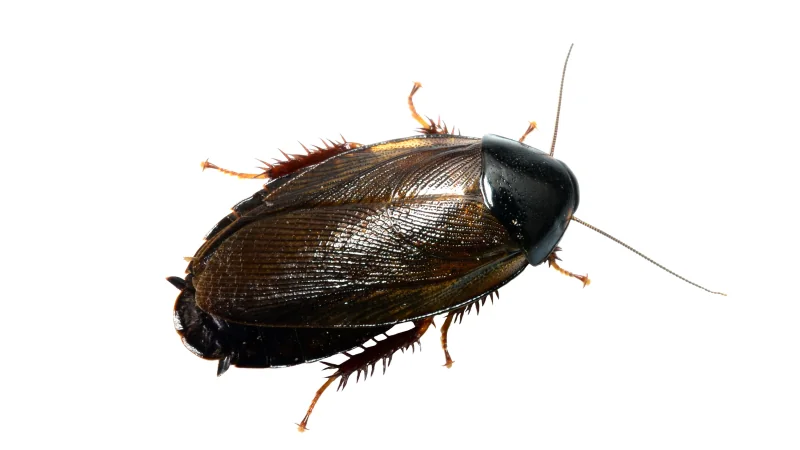
American cockroach (Periplaneta Americana)
This larger, reddish-brown cockroach prefers warm, humid areas like sewers, basements, and drains.
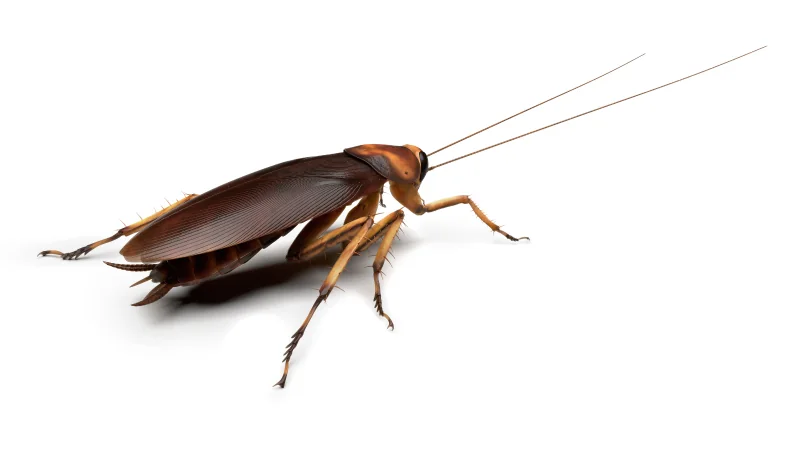
Oriental cockroach (Blatta orientalis)
This dark brown or black cockroach is often found outdoors in damp areas, such as leaf litter and mulch.
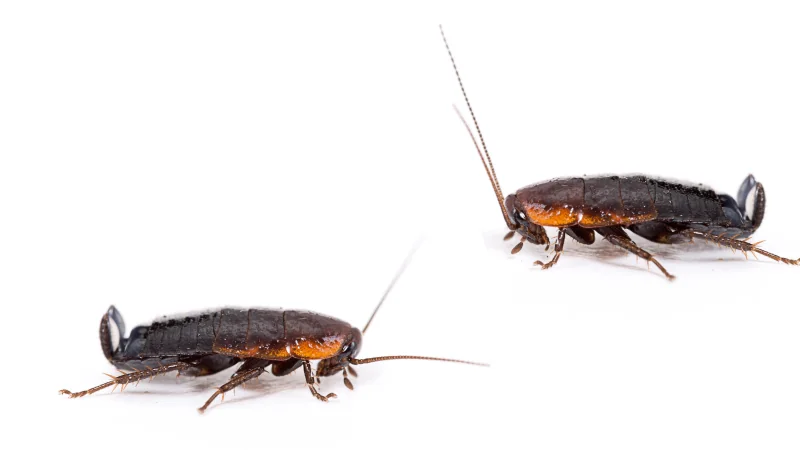
Cockroaches are nocturnal creatures, hiding during the day and emerging at night to search for food and water. They are omnivores, feeding on various organic materials, including food scraps, garbage, and faeces.
How Baby Cockroaches Look Like?
Baby cockroaches, or nymphs, are smaller and often lighter in colour than adults. They lack wings but have a body shape similar to adult cockroaches.
They are often found in the same areas as adult cockroaches, such as kitchens, bathrooms, and basements. If you see any signs of cockroach infestation, such as droppings or shed skin, it is important to take action quickly to prevent the problem from worsening.
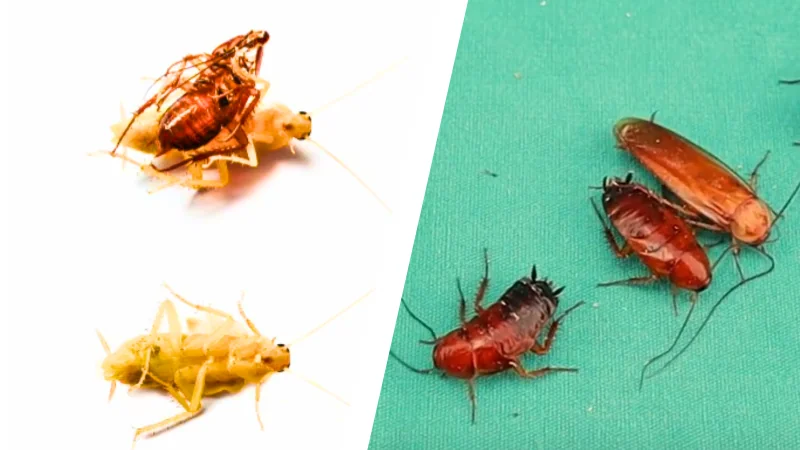
How Cockroach Eggs Look Like?
Cockroach eggs are typically enclosed in a casing called an ootheca. They might be glued to surfaces, hidden in cracks or crevices, or even attached to the body of a female cockroach.
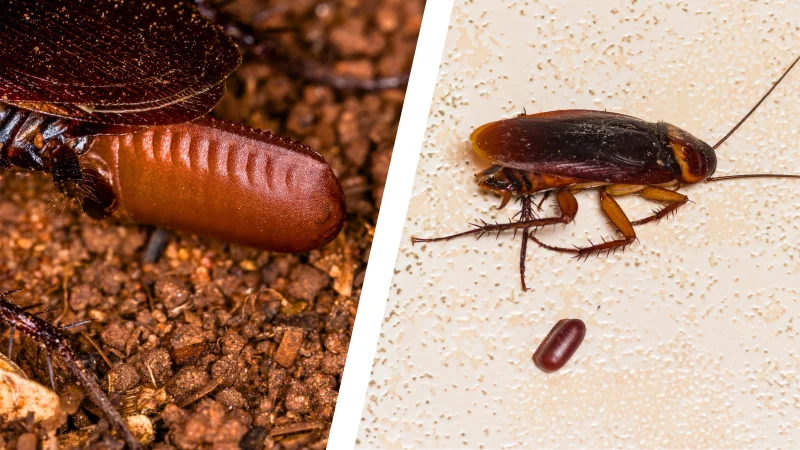
To identify cockroach eggs, look for the following characteristics:
- Size: Most oothecae are less than half an inch long.
- Shape: They are often oblong or capsule-shaped.
- Colour: Typically brown, reddish-brown, or black.
- Location: Often found in dark, warm, and humid areas.
- Texture: Can be smooth or have ridges.
Your Health Can Be at Risk (And Property, Too)
Cockroaches are a nuisance and pose significant health risks.
They can contaminate food and surfaces with bacteria and pathogens, leading to food poisoning and other illnesses.
Cockroach allergens can also trigger asthma and allergies in sensitive individuals.
In addition to health concerns, cockroaches can cause property damage. They can chew through paper, cardboard, and even electrical wiring, leading to potential safety hazards.
Cockroach Prevention
Preventing cockroach infestations during holidays in Spain is the most effective way to avoid the associated health risks and property damage.
Here are some essential preventive measures:
Maintain Cleanliness: Regularly clean kitchens, bathrooms, and other areas where cockroaches are commonly found. Wipe down surfaces, sweep and mop floors, and promptly clean up spills and food scraps.
Proper Food Storage: Store food in airtight containers, including pet food. Avoid leaving dirty dishes in the sink overnight.
Seal Entry Points: Seal cracks and crevices in walls, floors, and around pipes. Install screens on windows and doors.
Reduce Moisture: Fix leaky faucets and pipes. Use dehumidifiers in damp areas like basements.
Regular Garbage Disposal: Empty trash bins regularly and keep them tightly sealed.
Identifying Cockroach Infestations
Early detection of cockroach infestations is crucial for effective control. Here are some signs to look out for:
Cockroach Sightings: Seeing live cockroaches, especially during the day, indicates an infestation.
Droppings: Cockroach droppings resemble black pepper or coffee grounds and can be found near their hiding places.
Egg Cases: Cockroach egg cases are small, brown capsules that can be found attached to surfaces or hidden in cracks and crevices.
Musty Odor: A persistent musty odour can signify a large cockroach infestation.
What are Effective Cockroach Elimination Strategies?
If you suspect a cockroach infestation, taking immediate action is crucial. Here are some effective elimination strategies:
Baits: Cockroach baits contain insecticides that attract and kill cockroaches. Place them in areas where cockroaches are commonly seen.
Sprays: Insecticidal sprays can target cockroaches and their hiding places directly. Follow the instructions carefully and use them in well-ventilated areas.
Dust: Insecticidal dust can be applied in cracks and crevices where cockroaches in Spain hide. They provide long-lasting control.
Professional Pest Control: It’s advisable to seek professional pest control services for severe infestations or if DIY methods fail.
Cockroaches exist in many areas of Spain, including Madrid, Valencia, Malaga, Barcelona, Lanzarote, Mallorca, Tenerife, and Gran Canaria.
Practical steps for tourists:
- Be aware: Cockroaches are common and may be encountered in various settings.
- Keep food sealed: Store food in airtight containers to prevent attracting them.
- Dispose of trash properly: Use bins with lids and regularly remove the trash.
- Maintain cleanliness: Keep accommodations clean, especially kitchens and eating areas.
- Report infestations: If staying in a hotel or rental with a cockroach problem, notify management.
- Consider repellents: If concerned, use cockroach repellents or traps, especially in kitchens.
Can cockroaches fly, jump or bite?
Cockroaches in Spain vary in their acrobatic abilities. Some have wings but rarely fly. They can jump short distances and bite if threatened, though uncommon.
- American cockroach: Has wings, rarely flies, can bite.
- German cockroach: Has wings, doesn’t fly, can bite.
- Oriental cockroach: Has underdeveloped wings, doesn’t fly, can bite.
Can cockroaches climb?
Cockroaches can climb various surfaces due to the claws and adhesive pads on their legs.
Examples of surfaces cockroaches can climb:
- Wood
- Wall
- Brick
- Stone
- Some types of metal
Some smoother surfaces, like glass or polished metal, may be more difficult for them to climb.
Are Cockroaches in Spain Dangerous?
Cockroaches are not directly dangerous but pose health risks. They contaminate food and surfaces with bacteria like Salmonella, which can cause food poisoning (in case of emergency, check out emergency numbers in Spain). Cockroach allergens can trigger asthma and allergies. They are also a general sign of unsanitary conditions.
How to Get Rid of Cockroaches in Spain?
Effective cockroach control in Spain often involves a multi-faceted approach. Prevention is crucial, emphasizing cleanliness and minimizing food and liquids. Sealing cracks and crevices in walls and floors helps deter entry.
Various treatment methods exist, including insecticides, baits, and traps. Insecticides containing pyrethroids or fipronil are common, but professional application is often recommended for safety and efficacy. Baits containing hydramethylnon or indoxacarb can be effective, while sticky traps help monitor infestations.
Given the potential risks associated with insecticides, especially for children and pets, seeking professional pest control services is often advisable in Spain.
For more detailed instructions, read the guide on how to get rid of cockroaches in Spain.
Q: Is it normal to have cockroaches in your house in Spain?
A: Unfortunately, seeing a cockroach or two in Spain isn’t uncommon, especially during the warm months. The warm climate and plentiful food sources in houses make them a recurring issue.
Q: Should I be worried if I saw a cockroach?
A: A single sighting is a cause for concern but not full-blown panic. It’s best to take action to prevent an infestation.
Q: Can you get sick from being around cockroaches?
A: Cockroaches can carry bacteria and spread diseases like salmonellosis and dysentery.
Q: Are cockroaches bad to be around?
A: Yes, besides the ick factor, they can trigger allergies and asthma, especially for those with sensitivities.
Q: Will cockroaches crawl in your bed?
A: Cockroaches are nocturnal and will seek food and water anywhere they can, including your bed.
Q: Does sleeping with the light on keep cockroaches away?
A: Not really. While they prefer darkness, they will still venture out for food, even with the light on.
Q: Does a cockroach bite humans at night?
A: Cockroach bites are rare in humans, but they can happen if they feel threatened or are looking for a food source (like on your skin).
Q: How long does it take to get sick from cockroaches?
A: It depends on the specific disease and your individual health. Symptoms can appear within hours or take days.
Q: Why shouldn’t you squish a cockroach?
A: Squashing a roach can spread bacteria and attract other roaches.
Q: Should I freak out if I see a cockroach?
A: Stay calm, but take action. Seeing one roach might indicate more hiding nearby.
Q: Is there a cockroach problem in Spain?
A: Yes, Spain’s warm climate and increased insecticide resistance contribute to a more prominent cockroach problem.
Q: Why am I suddenly seeing baby roaches?
A: Cockroaches reproduce quickly, so if you see even a few, a nest might already be nearby.
Q: How do I know if I saw a baby cockroach?
A: Baby roaches look like wingless adults but smaller. They’ll be the same colour as the adult roaches in your area. See the images in this article to learn to identify them.
Q: Are cockroaches seasonal in Spain?
A: Somewhat. Their activity increases in the warmer months (spring and summer), but the season might be extended due to climate change.
Q: What smell do cockroaches hate?
A: Cockroaches dislike the scent of peppermint, bay leaves, and citrus peels. However, these methods may not be a long-term solution.
Q: How do you keep cockroaches away in Spain?
A: Keep your house clean, eliminate moisture sources (leaky pipes), seal cracks, and invest in professional pest control for significant infestations.
Q: Why are there cockroaches in my room at night?
A: They are nocturnal and might be attracted to crumbs, spills, or moisture in your room.
Q: Why do I find cockroaches in your kitchen?
A: Kitchens provide a perfect habitat, with easy access to food and water sources such as crumbs, spills, and pet food bowls.
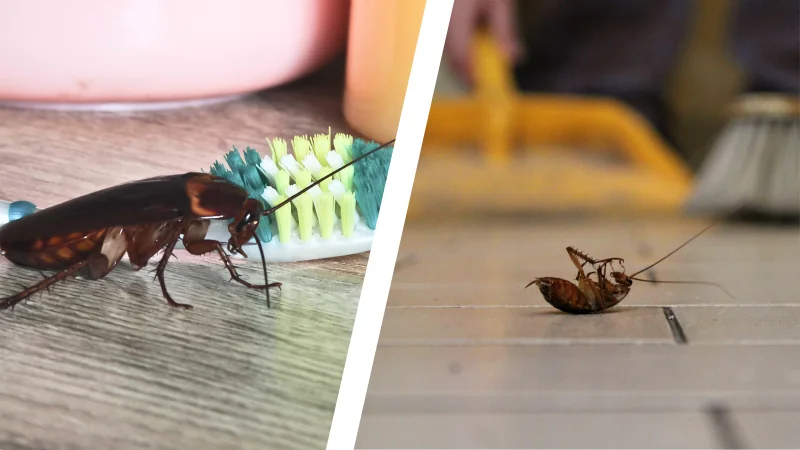




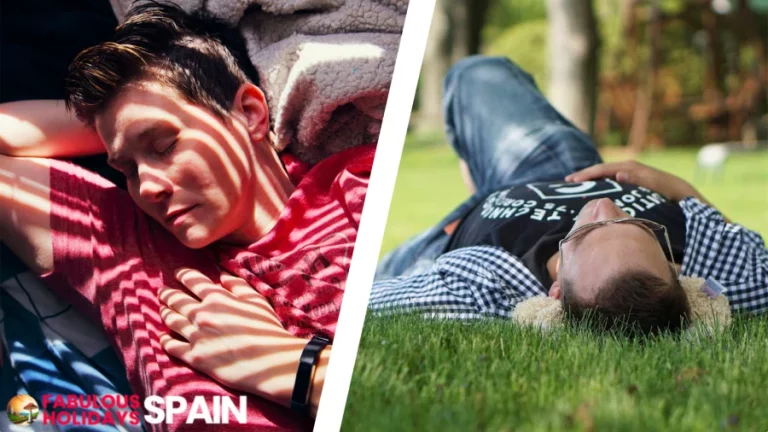

One Comment